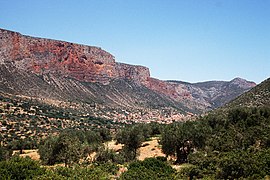This article needs additional citations for verification. (September 2023) |
Leonidio (Greek: Λεωνίδιο, Katharevousa: Λεωνίδιον, Tsakonian: Αγιελήδι) is a town and a former municipality in Arcadia, Peloponnese, Greece. Since the 2011 local government reform it is part of the municipality South Kynouria, of which it is a municipal unit.[2] The municipal unit has an area of 418.65 km2, the community 102.67 km2.[3] It is considered a traditional settlement.
Leonidio
Λεωνίδιο | |
|---|---|
 | |
| Coordinates: 37°10′N 22°51′E / 37.167°N 22.850°E | |
| Country | Greece |
| Administrative region | Peloponnese |
| Regional unit | Arcadia |
| Municipality | South Kynouria |
| Area | |
| • Municipal unit | 418.7 km2 (161.7 sq mi) |
| • Community | 102.7 km2 (39.7 sq mi) |
| Elevation | 40 m (130 ft) |
| Population (2021)[1] | |
| • Municipal unit | 5,315 |
| • Municipal unit density | 13/km2 (33/sq mi) |
| • Community | 3,792 |
| • Community density | 37/km2 (96/sq mi) |
| Time zone | UTC+2 (EET) |
| • Summer (DST) | UTC+3 (EEST) |
| Postal code | 223 00 |
| Area code(s) | 27570 |
| Vehicle registration | ΑΡ |
| Website | www.leonidio.gr[needs update] |
Name
editIn the local Tsakonian language, the only surviving descendant of Doric Greek, the town is called Agie Lidi.[4]
Landscape
editThe town of Leonidio, with a population of 3,826, emerges from a spectacular landscape, bound by two abrupt mountainsides enclosing the town from the north and south. The River Dafnon passes through the town, and its banks are linked with three bridges. The town is capital of the Tsakonia region, notable for its cultural and linguistic particularities, and the settlement itself offers striking and picturesque architecture; now a protected architectural site, there are very strict regulations for building within the town's limits.
Plaka
editPlaka is the picturesque port of Leonidio, situated 4 km from the town. It functions mainly with the help of tourism, but a small fishing fleet is also to be found; a well-regarded beach lies 4 km across the shore. The port takes in a number of taverns and bars immediately adjacent to the sea, while every August, it also hosts the "Tsakonian Eggplant Festival", attracting well-known chefs from across Europe and achieving ever-growing popularity.
History
editLeonidio is situated near the ancient city of Prasiae, which was an important harbour for Sparta until its ruin by the Athenians during the Peloponnesian War.
Modern Era
editToday, Leonidio is a lively and colourful town, especially in summer months, as a result of newly developing tourism. Agriculture, nevertheless, remains a main source of income for its residents, and the benefits of the exploitation of the plain are irreplaceable. The town is also famous for its unusual Easter celebration, when the custom of aerostata (air balloons) attracts spectators. Greek comedy writer Dimitrios Psathas once recommended the virtues of passing: "..carnival in Patras, and Easters in Leonidio".[citation needed]
In latter years it has become a well known tourist destination for rock climbing.[5]
Geography
editLeonidio is situated on the eastern coast of the Peloponnese and, although coastal, opening on to the Myrtoan Sea, it is also mainly mountainous, punctuated by the Parnon. Leonidio town itself, however, is to be found on the area's plain, which proves fertile and very important for the local economy, with its high level of agricultural employment. Apart from citrus fruit, pears, tomatoes and olives, the area's most famous and widely distributed product is the Tsakonian eggplant, characteristic in its sweet taste, and acknowledged and protected by the European Union. Three old windmills overlook the town.
Geology
editThanks to its position on the mountain of Parnon, the Leonidio municipality is home to a number of stunning geological formations, such as the Peleta Sinkhole, and the Propantes pothole (a vertical cave).
Demographics
editNewly developing tourism is also a vital part of the area, with its scenic, clean beaches and breathtaking mountain scenery. Notably, the area is part of Tsakonia, and the Tsakonian language is still spoken in some areas. Its communities take in the following: Leonidio, Vaskina, Agios Vasileios, Kosmas, Kounoupia, Mari, Paliochori, Paliochora, Peleta, Pigadi, Platanaki, Poulithra, Pragmatefti, Tsitalia, and Vlisidia.
See also
editReferences
edit- ^ "Αποτελέσματα Απογραφής Πληθυσμού - Κατοικιών 2021, Μόνιμος Πληθυσμός κατά οικισμό" [Results of the 2021 Population - Housing Census, Permanent population by settlement] (in Greek). Hellenic Statistical Authority. 29 March 2024.
- ^ "ΦΕΚ B 1292/2010, Kallikratis reform municipalities" (in Greek). Government Gazette.
- ^ "Population & housing census 2001 (incl. area and average elevation)" (PDF) (in Greek). National Statistical Service of Greece. Archived from the original (PDF) on 2015-09-21.
- ^ *Nicholas, Nick. (2019). "A critical lexicostatistical examination of Ancient and Modern Greek and Tsakonian". Journal of Applied Linguistics and Lexicography. 1 (1): 18–68. doi:10.33910/2687-0215-2019-1-1-18-68.. Page 19.
- ^ "Leonidio rock climbing and sport climbing". Climb Europe – Rock climbing and walking in Europe and around the World. Retrieved 2022-01-05.
External links
edit- Information about Leonidio (in Greek)
- Info and news about Leonidio (in Greek)
- Info about rock climbing in Leonidio

